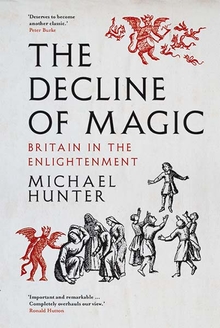During a single day of bloated idleness last week, I managed to watch three televised ghost stories, adapted from the works of Charles Dickens and a brace of Jameses: MR and Henry. Christmas, moreover, will have proved again to millions that Harry Potter and his wizard companions have lost none of their potency as divinities in the 21st-century household. The creatures dismissed by a sceptical thinker in 1709 as “ghosts, hobgoblins, witches and spectres” now enjoy a second life across swathes of British popular and literary culture. They have seldom seemed so robust and so resilient. Yet the afterlife of such supernatural entities, now the cast of choice for tall tales of every kind, rests on the utter annihilation of their first existence. They began, after all, as beings whose supposed reality shaped the ideas and actions of almost everybody in pre-modern communities.
The “disenchantment” of our world, and the wholesale migration of the paranormal realm into the safely fenced domain of fantasy and fiction, has long fascinated historians. In 1971, Keith Thomas published a classic account of the process as it unfolded in Britain: Religion and the Decline of Magic. Now, almost half-a-century later, Michael Hunter revises the story to suggest that Thomas and his followers ignored some crucial solvents at work in the dissolution of magical beliefs. His closely argued book modifies rather than overturns the conventional narrative, which sees the cleansing forces of Enlightenment banish the clutter of superstition from mainstream thought, law, and, indeed, religion. But The Decline of Magic: Britain in the Enlightenment, despite a catch-all title that promises more than Hunter’s tightly-focused study can deliver, does break fresh ground in the quest to understand how minds change, how paradigms shift, and how societies progress.
England’s last significant witch trial, of Jane Wenham, took place in 1712. (Pictured below: Amanda Bellamy in Rebecca Lenkiewicz's 2015 play Jane Wenham: Witch of Walkern). She was convicted, but pardoned. In 1735, the Witchcraft Act redefined all claims to magical powers as a matter of criminal fraud, rather than diabolical possession. In legal terms, "magic" now became imposture. By 1749, the radical clergyman Conyers Middleton could declare that “the belief of witches is now utterly extinct”. Yet Keith Thomas amassed much evidence to show that deep-rooted beliefs in occult events and forces lingered on much later than that. Hunter does not dispute the widespread endurance of supernatural lore and rites as part of underground (or even above-ground) popular experience – one fascinating chapter here explores “second sight” in the Highlands of Scotland, its defenders and its debunkers. He does, however, suggest another route towards the “disenchantment” that discredited magic among the thought-leaders and law-makers of the late 17th and 18th century. And his model of “intellectual change and its stimuli” turns out to owe much to our troublesome old friends, the liberal metropolitan elite.
 For Keith Thomas and historians who followed in his wake, the rise of modern science killed magic. In this interpretation, the experimental “virtuosi” of the Royal Society (founded 1660) and their supporters turned their corrosively sceptical minds to ghosts, witches and spirits in order to disprove their existence and expel them from serious study. Hunter, though, revisits the records, and finds the supposedly magic-hating scientists in a much more ambivalent mood. Some, indeed, were hard-core sceptics who set out to expose and ridicule supernatural practices and happenings. Others, though, including the polymathic chemist-philosopher Robert Boyle, not only believed in a “separate supernatural realm”. They aimed to find firm evidence of its reality. Sympathetically, Hunter contrasts the “heroic open-mindedness” of Boyle and his allies as they sought experimental proof of phantoms, spells or premonitions with the “intellectual arrogance” of the pure “Newtonians” – who thought it all a load of medieval mumbo-jumbo. Thus the internally divided Royal Society reached “a kind of stalemate” on the question of magic and witchcraft. Many of its leaders, after all, remained pious Christians who feared that to challenge the very existence of “infernal Spirits” would open “a door to the denial of the Deity” (as one writer put it in 1695).
For Keith Thomas and historians who followed in his wake, the rise of modern science killed magic. In this interpretation, the experimental “virtuosi” of the Royal Society (founded 1660) and their supporters turned their corrosively sceptical minds to ghosts, witches and spirits in order to disprove their existence and expel them from serious study. Hunter, though, revisits the records, and finds the supposedly magic-hating scientists in a much more ambivalent mood. Some, indeed, were hard-core sceptics who set out to expose and ridicule supernatural practices and happenings. Others, though, including the polymathic chemist-philosopher Robert Boyle, not only believed in a “separate supernatural realm”. They aimed to find firm evidence of its reality. Sympathetically, Hunter contrasts the “heroic open-mindedness” of Boyle and his allies as they sought experimental proof of phantoms, spells or premonitions with the “intellectual arrogance” of the pure “Newtonians” – who thought it all a load of medieval mumbo-jumbo. Thus the internally divided Royal Society reached “a kind of stalemate” on the question of magic and witchcraft. Many of its leaders, after all, remained pious Christians who feared that to challenge the very existence of “infernal Spirits” would open “a door to the denial of the Deity” (as one writer put it in 1695).
So the fading of supernatural beliefs in Britain over the century of so after 1660 cannot, in Hunter’s view, be framed as a simple tale of science trouncing superstition. Instead, he pays close attention to the acidic drip of satire and mockery – of sceptical, anti-supernatural wit as a social fashion. From the period of the Restoration onwards, a teasing incredulity about spirits and magic became an acknowledged part of a smart, London-centred mindset: the sort of attitude that might also put orthodox religion in doubt. Even Royal Society scientists began to fear that the anti-witchcraft scoffing of this freethinking coffee-house elite concealed that ultimate bugbear – atheism. Laughter, they worried, might finish by banishing not only superstition, but God himself. Joseph Glanvill, not only a theologian but an influential advocate for Royal Society science, complained in 1668 that these dangerous unbelievers loved to generate “a loud laugh, upon an idle tale of a Devil, or a Witch”. By the late 18th century, the Methodist evangelist John Wesley – who believed in the objective reality of Satanic possession – could assert that “the infidels have hooted witchcraft out of the world”.
Hunter’s account of the triumph of the metropolitan mockers pivots on an analysis of key printed works and some infamous cases, such as the alleged poltergeist of the 1660s known as “the Drummer of Tedworth”. He believes that the books and pamphlets informing us about the opinions of anti-magical scoffers represent merely “the tip of an iceberg of scepticism”. Writers and thinkers with heterodox ideas, he argues, would often think twice about publishing them. Censorship, and self-censorship, put a brake on the public expression of any brand of disbelief that might incur the charge of “atheism”. From the printed record we do have, often hostile to the debunkers of magic, he infers the vitality and extent of anti-superstitious talk and argument. Frustratingly, though, he can’t produce very much solid evidence of “this elusive oral dimension” to the movement of ideas. Since the oral voice of scepticism may be “under-represented in the printed record”, as Hunter admits, I would have liked to see him dig deeper for it – in novels, plays, diaries, letters and other unofficial windows into the minds of the time.
 Only a few authors, such as the pioneering sceptic John Wagstaffe, dared commit wholly anti-supernatural arguments to print before the 18th century (in his 1669 tract, The Question of Witchcraft Debated). Hunter, however, maintains that the controversial freethinkers made a crucial contribution to the retreat of magical beliefs, at least among the elite. Gradually, their scepticism about the supernatural spread. It rippled out from the subversive wits of London to mainstream clerics, scientists, philosophers and medics. “Occult” occurrences came to be seen as cynical frauds, as primitive throwbacks or – in a decisive shift – as symptoms of mental illness.
Only a few authors, such as the pioneering sceptic John Wagstaffe, dared commit wholly anti-supernatural arguments to print before the 18th century (in his 1669 tract, The Question of Witchcraft Debated). Hunter, however, maintains that the controversial freethinkers made a crucial contribution to the retreat of magical beliefs, at least among the elite. Gradually, their scepticism about the supernatural spread. It rippled out from the subversive wits of London to mainstream clerics, scientists, philosophers and medics. “Occult” occurrences came to be seen as cynical frauds, as primitive throwbacks or – in a decisive shift – as symptoms of mental illness.
By 1762, William Hogarth might engrave his burlesque print of “Credulity, Superstition and Fanaticism” (pictured top), knowing that majority opinion would hoot merrily along with him. In the 1770s, a Highland clergyman could seek to discredit “second sight” and state that “In proportion as the light of knowledge has dawned upon mankind, their eagerness for wonders and belief in supernatural endowments have abated”. The avant-garde mockery of those “ghosts, hobgoblins, witches and spectres” had evolved into middle-of-the-road common sense. Hunter demonstrates that not only sober scientists but freethinking wits and sceptics had laid the foundations for “confidence in a serene and stable world in which the disruptiveness of magic no longer seemed to have a place”. So the way was opened for magic, prophecy and witchcraft to flee into “the culture of Romanticism”, vital components of fiction rather than faith. There they remain, as entertainment, as escapism – and as spookily big business.
- The Decline of Magic: Britain in the Enlightenment by Michael Hunter (Yale University Press, £20)















Add comment